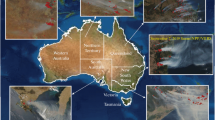Abstract
In this paper we summarize the results of the satellite monitoring of various types of wildfires, as well as emissions of carbon-containing the CO and CO2 gases and the fine PM2.5 aerosol into the atmosphere due to wildfires, throughout the Russian Federation and several of its regions in 2005–2017. The methodology and features of the satellite system used for the monitoring are described. An analysis of the overall estimations of the total wildfire areas, areas of burnt-out forests, as well as the volumes of harmful contaminant emissions due to them, is given. It is shown that between 2005 and 2017 the total areas of all types of wildfires in Russia, including forest fires, more than halved due to the measures taken on urgent fire detection and well-timed actions to extinguish them. The burnt-out areas reached a peak of 234 700 km2 in 2006 were minimal (74 000 km2) in 2013. The largest areas of burnt-out forest were in the Siberian Federal District. Fires spread to a maximum of 53 600 km2 in this region in 2012, while the total burnt-out areas covered 65 000 km2.







Similar content being viewed by others
REFERENCES
Andreae, M.O. and Merlet, P., Emission of trace gases and aerosols from biomass burning, Global Biogeochem. Cycles, 2001, vol. 15, no. 4, pp. 955–966.
Bondur, V.G., Aerospace methods and technologies for monitoring oil and gas areas and facilities, Izv., Atmos. Ocean. Phys., 2011, vol. 47, no. 9, pp. 1007–1018.
Bondur, V.G., Modern approaches to processing large hyperspectral and multispectral aerospace data flows, Izv., Atmos. Ocean. Phys., 2014, vol. 50, no. 9, pp. 840–852.
Bondur, V.G., Satellite monitoring of trace gas and aerosol emissions during wildfires in Russia, Izv., Atmos. Ocean. Phys., 2016, vol. 52, no. 9, pp. 1078–1090.
Bondur, V.G. and Ginzburg, A.S., Emission of carbon-bearing gases and aerosols from natural fires on the territory of Russia based on space monitoring, Dokl. Earth Sci., 2016, vol. 466, no. 2, pp. 148–152.
Bondur, V.G. and Gordo, K.A., Satellite monitoring of wildfires and their effects in the Northern Eurasia, in 17th Int. Multidisc. Sci. GeoConf. 29 June–5 July, 2017, Albena, Bulgaria, 2017, pp. 227–238.
Bondur, V.G. and Starchenkov, S.A., Methods and programs for the processing and classification of aerospace images, Izv. Vyssh. Uchebn. Zaved., Geod. Aerofotos’emka, 2001, no. 3, pp. 118–143.
Bondur, V.G., Krapivin, V.F., and Savinykh, V.P., Monitoring i prognozirovanie prirodnykh katastrof (Monitoring and Forecasting of Natural Disasters), Moscow: Nauchny mir, 2009.
Bondur, V.G., Gordo, K.A., and Kladov, V.L., Spacetime distributions of wildfire areas and emissions of carbon-containing gases and aerosols in Northern Eurasia according to satellite-monitoring data, Izv., Atmos. Ocean. Phys., 2017, vol. 53, no. 9, pp. 859–874.
Isaev, A.S., Korovin, G.N., and Sukhikh, V.I., Ekologicheskie problemy pogloshcheniya uglekislogo gaza posredstvom lesovosstanovleniya I lesorazvedeniya v Rossii: Analiticheskii obzor (Environmental Issues of Carbon Dioxide Absorption by Reforestation and Afforestation in Russia: Analytical Review), Moscow: Tsentr ekologicheskoi politiki Rossii, 1995.
Jia, G.J., Burk, I.C., Goetz, A.F.H., Kaufmann, M.R., and Kindel, B.C., Assessing spatial patterns of forest fuel using AVIRIS data, Remote Sens. Environ., 2006, vol. 102, nos. 3–4, pp. 318–327.
Key, C.H. and Benson, N.C., Landscape assessment: Remote sensing of severity, the normalized burn ratio, in FIREMON: Fire Effects Monitoring and Inventory System, General Technical Rep. RMRSGTR-164-CD: LA1-LA51, Ogden, UT: USDA Forest Service, Rocky Mountain Res. Stat., 2005.
Kulmala, M., Lappalainen, H.K., Petäjä, T., Bondur, V., et al., Introduction: The Pan-Eurasian Experiment (PEEX)—multidisciplinary, multiscale and multicomponent research and capacity-building initiative, Atmos. Chem. Phys., 2015, no. 15, pp. 13085–13096. doi 10.5194/acp-15-13085-2015
Lappalainen, H.K., Kerminen, V.-M., and Petäjä, T., Bondur, V., et al., Pan-Eurasian Experiment (PEEX): Towards a holistic understanding of the feedbacks and interactions in the land–atmosphere–ocean–society continuum in the Northern Eurasian region, Atmos. Chem. Phys., 2016, no. 16, pp. 14421–14461. doi 10.5194/acp‑16–14421–2016
Lopez Garcia, M.J. and Caselles, V., Mapping burns and natural reforestation using thematic mapper data, Geocarto Int., 1991, no. 1, pp. 31–37.
Miller, J.D. and Thode, A.E., Quantifying burn severity in a heterogeneous landscape with a relative version of the Delta Normalized Burn Ratio (DNBR), Remote Sens. Environ., 2007, no. 109, pp. 66–80.
Miller, J.D. and Yool, S.R., Mapping forest post-fire canopy consumption in several overstory types using multi-temporal Landsat TM and ETM data, Remote Sens. Environ., 2002, vol. 82, nos. 2–3, pp. 481–496.
Seiler, W. and Crutzen, P.J., Estimates of gross and net fluxes of carbon between the biosphere and atmosphere from biomass burning, Clim. Change, 1980, vol. 2, no. 3, pp. 207–247.
Shvidenko, A.Z., Shchepashchenko, D.G., McCallum, I., Lakyda, I.P., Vaganov, E.A., Sukhinin, A.I., and Maksyutov, Sh.Sh., Impact of wildfire in Russia between 1998–2010 on ecosystems and the global carbon budget, Dokl. Earth Sci., 2011, vol. 441, no. 2, pp. 1678–1682.
Wiedinmyer, C., Quayle, B., Geron, C., et al., Estimating emissions from fires in North America for air quality modeling, Atmos. Environ., 2006, vol. 40, no. 19, pp. 3419–3432.
ACKNOWLEDGMENTS
This work was carried out with financial support of the Ministry of Education and Science of the Russian Federation within the Federal Target Programme “Research and development on priority directions of scientific and technological complex of Russia for 2014–2020” (unique project ID RFMEFI58317X0061).
Author information
Authors and Affiliations
Corresponding author
Additional information
Translated by V. Alekseev
Rights and permissions
About this article
Cite this article
Bondur, V.G., Gordo, K.A. Satellite Monitoring of Burnt-out Areas and Emissions of Harmful Contaminants Due to Forest and Other Wildfires in Russia. Izv. Atmos. Ocean. Phys. 54, 955–965 (2018). https://doi.org/10.1134/S0001433818090104
Received:
Published:
Issue Date:
DOI: https://doi.org/10.1134/S0001433818090104



